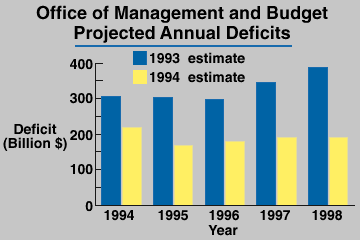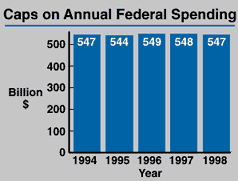Archive
Slowing the Red Ink
In early 1993, the Office of Management and Budget projected annual deficits, and in July 1994, a year after the President and Congress agreed to a five-year deficit reduction plan, OMB projected annual deficits, as shown in illustration.
The budget law, officially the Omnibus Budget Reconciliation Act of 1993, was designed to cut more than a half-trillion dollars off the projected deficits of 1994-98 through a balance of spending cuts and tax increases. Now, for the first time since Harry Truman was President, the deficit is expected to fall at least three years in a row--from $290 billion in 1992, to $255 billion in 1993, to the much lower estimates, cited above, for 1994 and 1995. As a share of the economy, a key measure of its impact on economic growth, the deficit will fall from 4.9 percent in 1992 to 2.4 percent in 1995--its lowest level since 1979.
In fact, the 1993 law is exceeding all expectations. While the spending and tax changes account for the half-trillion dollars in savings mentioned above, unexpectedly strong economic growth has increased the five-year deficit savings to almost $700 billion. Tax receipts are higher, while spending on unemployment compensation and some other social programs is lower.
And yet, some officials may have foreseen this year's strong economic performance, which continues to add millions of new jobs to the economy. As Federal Reserve Chairman Alan Greenspan said in early 1994:
The actions taken last year to reduce the federal budget deficit have been instrumental in creating the basis for declining inflation expectations and easing pressures on long-term interest rates. Although we may not all agree on the specifics of the deficit reduction measures, the financial markets are apparently inferring that, on balance, the federal government will be competing less vigorously for private savings in the years ahead. [3]
Deficit reduction and economic growth go hand-in-hand. All else being equal, the former should lead to the latter. As Greenspan suggested, by reducing future deficits, the Administration and Congress have ensured that the federal government will drain less from the nation's pool of savings, thus freeing up more of those funds for productive private investments. [4]
A key element in the revised deficit forecasts are strict new caps on annual spending. In each of the next five years, total federalspending on discretionary programs [5]--that is, non-entitlement domestic programs, defense, and international aid--must fit undera pre-determined overall limit. From year to year, the caps are the most stringent that the federal government has ever adopted.
Adjusted for emergency spending and technical changes, they now stand at: [6]

Essentially, the President and Congress have frozen discretionary spending for the next five years, even prohibiting increases to account for inflation. By way of comparison, discretionary programs rose 4.8 percent a year in nominal terms under Presidents Reagan and Bush.
Almost every major category of federal spending is expected to hold steady or fall as a share of the economy over the next decade. That includes Social Security, most other entitlements, civilian and military retirement programs, discretionary spending, and interest on the national debt. The only exception is federal health care spending, represented almost entirely by Medicare and Medicaid.
It is, in fact, only because of those two programs that the deficit is expected to begin rising again in the late 1990s. Only by reining in health care costs, as the President has urged for nearly two years, can the government solve its deficit dilemma for good.
Continue
Return to Table of Contents